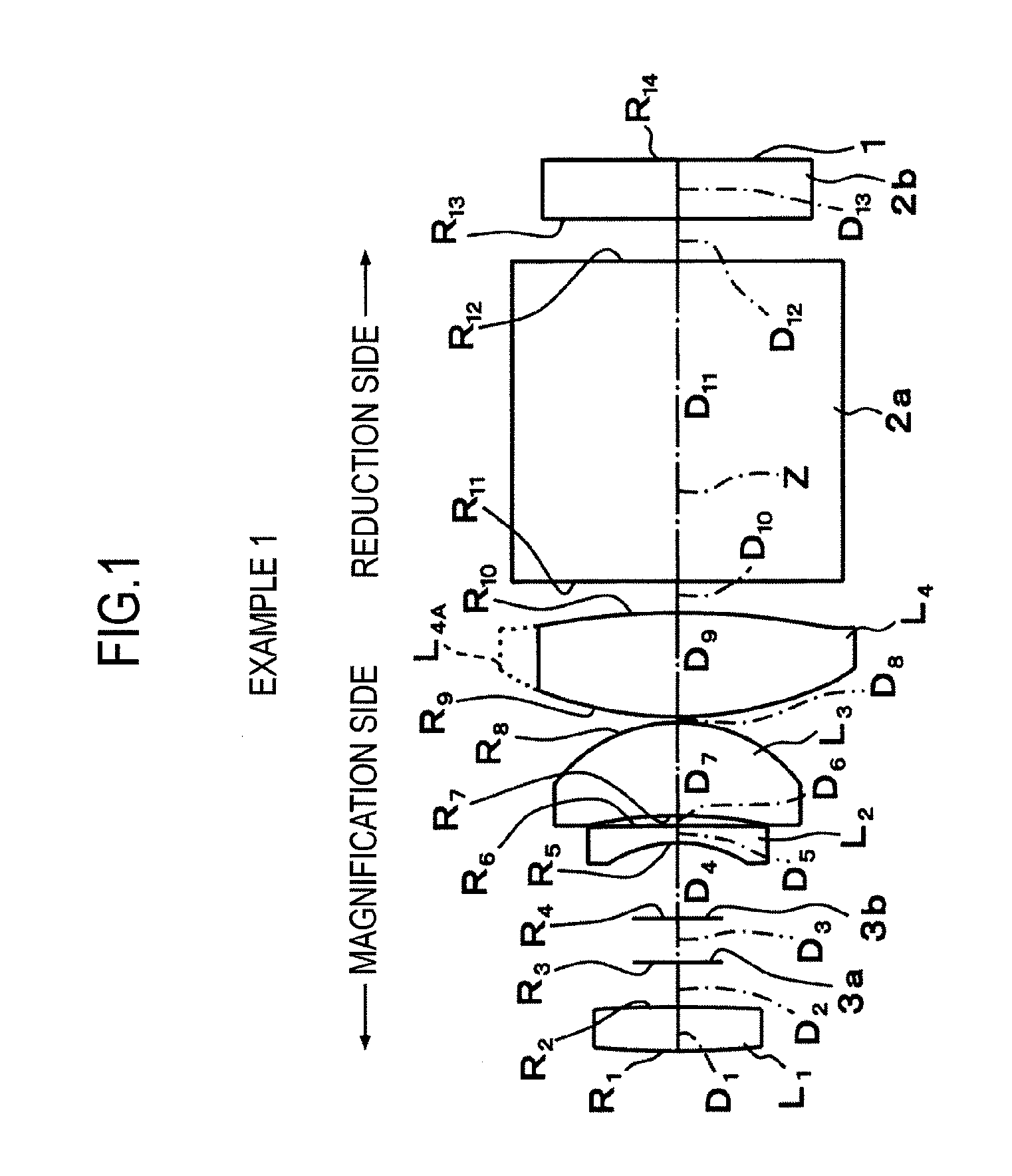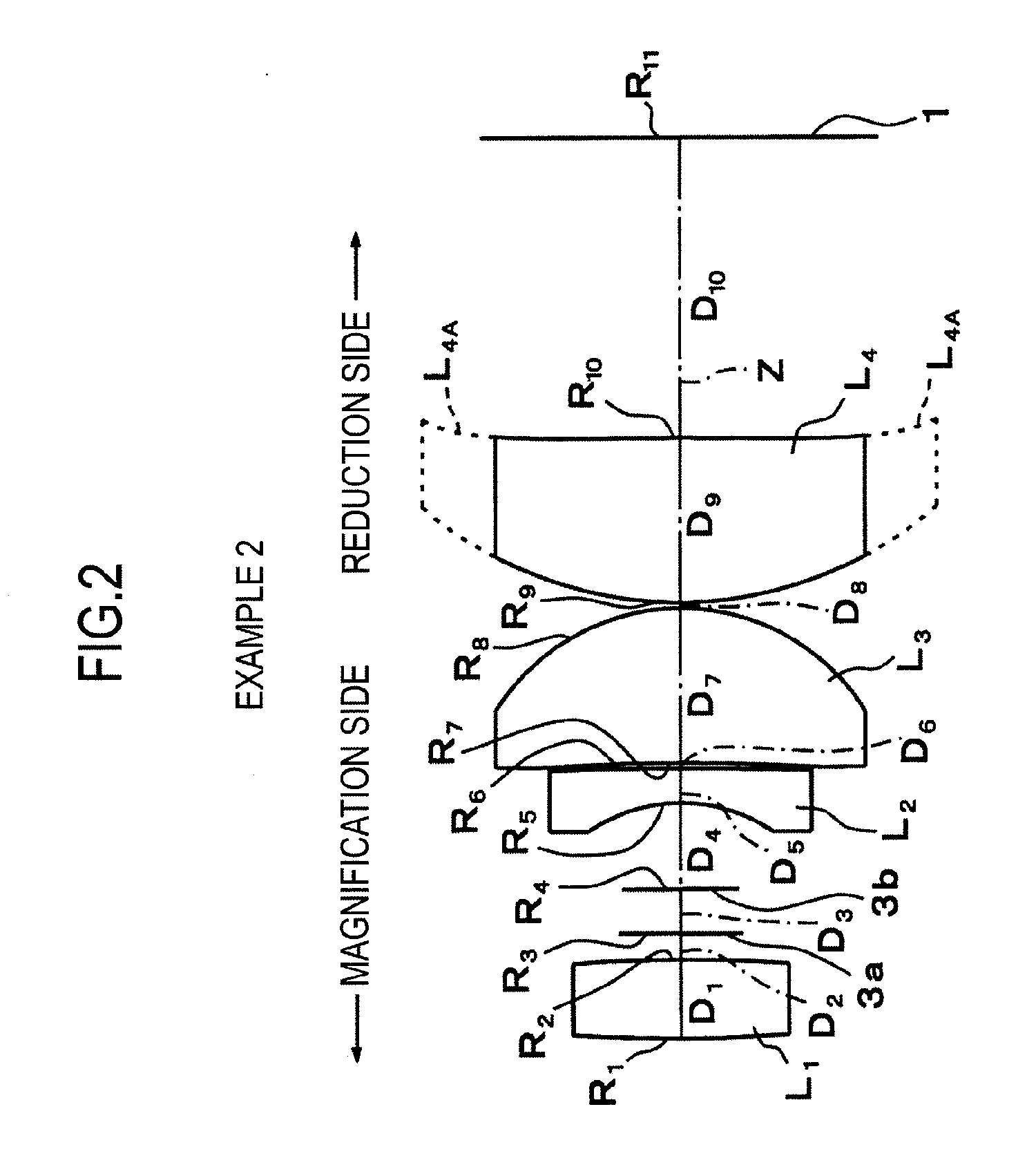Small projection lens and projection display device using the same
a projection display device and small technology, applied in the field of small projection lenses, can solve the problems of increased image size at a short distance, increased image size of a reduction-side lens, and difficulty in projecting images, and achieve the effects of wide angle of view, high projection performance, and high portability
- Summary
- Abstract
- Description
- Claims
- Application Information
AI Technical Summary
Benefits of technology
Problems solved by technology
Method used
Image
Examples
example 1
[0195]As shown in FIG. 1, a projection lens according to Example 1 includes a first lens L1, which is a biconvex lens, an aperture 3a, an aperture diaphragm (or an aperture) 3b, a second lens L2, which is a negative meniscus lens having a concave surface facing a magnification side, a third lens L3, which is a positive meniscus lens having a convex surface facing a reduction side, and a fourth lens L4, which is a biconvex lens having aspheric surfaces at both surfaces on the optical axis Z. The first to fourth lenses are arranged in this order from the magnification side.
[0196]The fourth lens L4 arranged closest to the reduction side is formed in a non-circular shape including an effective light beam transmission area to remove an unnecessary lens portion (a portion disposed at an upper part of FIG. 1) L4A (a so-called D-cut is performed), in order to prevent the outside diameter of a reduction-side lens from being excessively large.
[0197]The aspheric shapes of both surfaces of the ...
example 2
[0204]The structure of a projection lens according to Example 2 is shown in FIG. 2, and the structure of the projection lens according to Example 2 is substantially similar to that according to Example 1. However, the projection lens is configured so as to correspond to one light valve. Therefore, the glass block 2a for color composition shown in Example 1 is not provided between the fourth lens L4 and the image display surface 1 of the light valve. In addition, the illustration of the cover glass 2b of the light valve is also omitted.
[0205]The fourth lens L4 arranged closest to the reduction side is formed in a non-circular shape including an effective light beam transmission area to remove an unnecessary lens portion (a portion disposed in the vertical direction of FIG. 2) L4A (a so-called D-cut is performed), in order to prevent the diameter of a reduction-side lens from being excessively large.
[0206]The aspheric shapes of both surfaces of the fourth lens L4 are defined by the ab...
example 3
[0210]The structure of a projection lens according to Example 3 is shown in FIG. 3, and is substantially similar to that according to Example 1 except that the second lens L2 is biconcave lens.
[0211]The so-called D-cut according to Example 1 is not performed in Example 3.
[0212]The aspheric shapes of both surfaces of the fourth lens L4 are defined by the above-mentioned aspheric expression.
[0213]In Table 3, an upper part shows the curvature radius R of each lens surface in the projection lens according to Example 3, the on-axis surface spacing D between the lenses, the refractive index Nd of each lens with respect to the d-line, and the Abbe number νd thereof. In addition, in Table 3, a lower part shows an aspheric coefficient indicating each aspheric surface.
TABLE 3Surface NumberRDNdνdOBJ∞700.000 155.0561.4601.846723.8 2−35.3620.900 3 (mask)∞2.820 4 (mask)∞2.090 5−4.3320.6001.846723.8 668.7880.390 7−19.1332.9701.772549.6 8−5.2130.100 9*14.0913.2101.693553.210*−18.3181.71011∞12.0001....
PUM
 Login to View More
Login to View More Abstract
Description
Claims
Application Information
 Login to View More
Login to View More - R&D
- Intellectual Property
- Life Sciences
- Materials
- Tech Scout
- Unparalleled Data Quality
- Higher Quality Content
- 60% Fewer Hallucinations
Browse by: Latest US Patents, China's latest patents, Technical Efficacy Thesaurus, Application Domain, Technology Topic, Popular Technical Reports.
© 2025 PatSnap. All rights reserved.Legal|Privacy policy|Modern Slavery Act Transparency Statement|Sitemap|About US| Contact US: help@patsnap.com



